When INFJs and ESTPs Fall in Love – The Joys and Struggles
Opposites attract, right? That’s a statement many of us can agree on. While a kindred spirit can be a wonderful thing, there’s something exciting and fascinating about someone who’s personality contrasts our own in intriguing ways. At first glance, ESTPs and INFJs would seem like a terrible match. After all, they have completely different letters, right? Well, that’s what a lot of people think, but actually this is one of the most common pairings I come across as an MBTI® practitioner (although many of the ESTPs I meet have been mistyped as ENTJs or ENTPs). I also can speak from firsthand experience because I’m an INFJ married to an ESTP myself!
So what makes this pairing so compatible? What are the pros and cons in this relationship? Let’s find out!
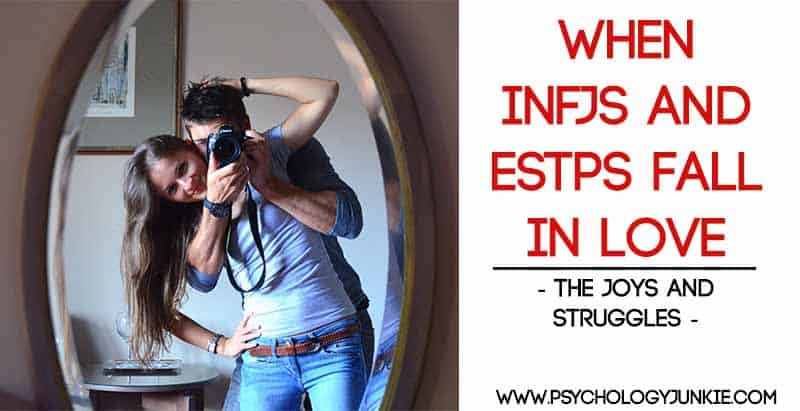
Not sure what your personality type is? Take our new personality questionnaire here. Or you can take the official MBTI® here.
P.S. If you want even more in-depth information on INFJs and relationships, careers, parenthood and more check out my eBook: The INFJ – Understanding the Mystic.
#1 – INFJs and ESTPs are Ego-Syntonic
These two types share the exact same functions. This means that even though we prefer using them in a different order, we still use the same perceiving functions and we still use the same judging functions. Just take a look below:
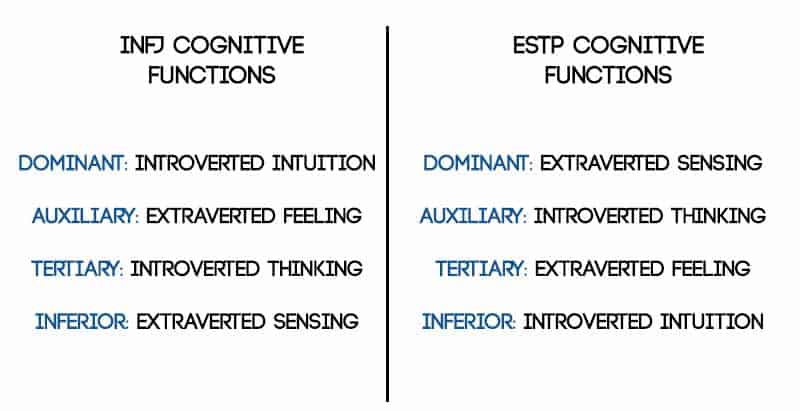
Do you see how the INFJ and ESTP have the exact same functions but in a completely reversed order? In contrast, let’s look at another type that has more LETTERS in common with the INFJ but completely different functions.
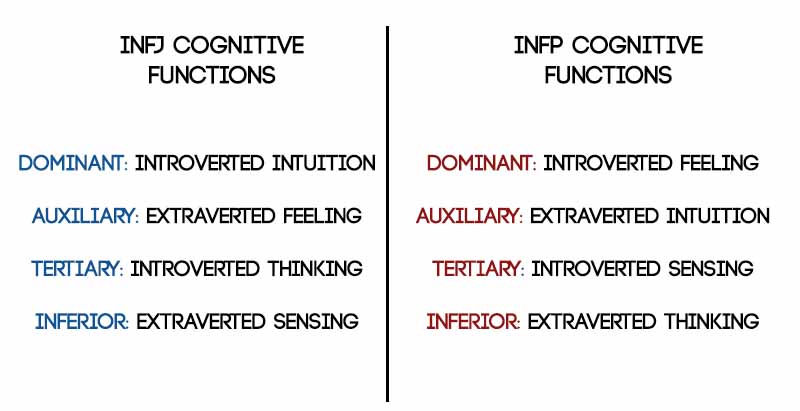
Okay, so INFJs and INFPs have three of the same letters, but they have completely. different. functions. This doesn’t mean that an INFJ and an INFP can’t get along, in fact, they often do, but there are unique misunderstandings that occur in that relationship that don’t happen in the INFJ/ESTP relationship.
Keep in mind: Most people who type as INFJ from online tests are actually INFPs or ISFPs, so these particular pros and cons may be very different if you’re dealing with mistypes. IXFP/ESTP dynamics are extremely different from INFJ/ESTP dynamics.
#2 – ESTPs and INFJs Often Instinctively “Get” Each Other
These two types will both perceive using Ni and Se. They will both decide using Fe and Ti. The ESTP will give precedence to Se and Ti and the INFJ will give precedence to Ni and Fe, BUT they will both generally understand where the other person is coming from when they decide because they still have those functions.
For example, when an INFJ (let’s call her Laura) make a Fe-based decision (considering harmony/feelings/interpersonal dynamics), her husband (an ESTP) generally gets it. He isn’t in the dark about why Laura made that decision, because he also uses Fe. He can easily put together the dots that led her to reaching a conclusion. In contrast, Laura’s STJ relatives are much more confused because they don’t have Fe in their function stack, they use Te and Fi to decide (functions Laura doesn’t have in her primary stack).
In the same way, when Laura’s ESTP husband uses Se to perceive, she can understand it, even if she prefers to use Ni. When people use Si Laura has to work extra hard to understand it. People who are ego-syntonic will naturally “get” each other in many ways, even if they seem very different outwardly.
Will you totally understand each other all the time? No. No couple is capable of this! I wish though!
#3 – We Both Help Each Other Grow Personally
INFJs lead with Introverted Intuition, which is the ESTP’s inferior or “aspiring” function. ESTPs lead with Extraverted Sensing, which is the INFJ’s inferior/”aspiring” function. You might think this is a bad thing, but it actually can be very good.
We aspire to use our inferior function well, but we tend to struggle with it on a daily basis. At the same time, we are often drawn to people who use this function well. Because we struggle with wielding our inferior function, when other people use it well we are instantly impressed and we may seek their company so we too can grow in this area.
It’s like being a struggling athlete but spending time around an accomplished athlete because deep down you know you can learn from them and they have that ingredient you’re missing. We’re naturally drawn to each other because the other possesses a process that we need to develop.
INFJs and ESTPs often have an innate attraction for each other, but attraction isn’t everything. We also can stimulate personal growth in each other by helping the other person develop their weaker functions!
#4 – INFJs and ESTPs Naturally Know How to Comfort Each Other
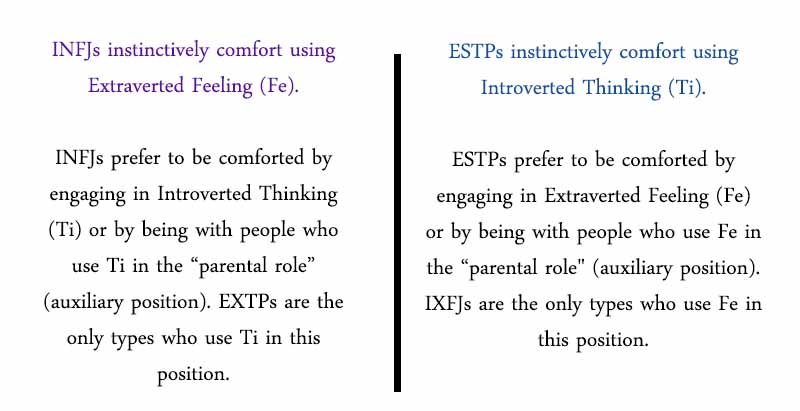
Each of us has a tertiary “Child” function. The INFJ’s tertiary function is Introverted Thinking (Ti), and the ESTP’s tertiary function is Extraverted Feeling (Fe). We each find comfort in that function and we prefer to be comforted by that function in others. INFJs tend to comfort using Fe (their auxiliary “parent” function) and ESTPs like to comfort using Ti (their auxiliary “parent” function).
Have I lost you? I hope not. All this to say that INFJs instinctively comfort using the mode that ESTPs like to be comforted in, and vice versa.
#5 – ESTPs Know How to Help INFJs “Lighten Up”
INFJs tend to take life very seriously. Taking things one day at a time and “stopping to smell the roses” can be hard for them when they’re trying to figure out the cosmic significance of every moment.
ESTPs naturally tend to take life one moment at a time, and they are often natural optimists. According to the MBTI® Manual, ESTPs experience the least stress of the 16 personality types. This is probably because they are always seeing opportunities and always learning and adapting and trying to figure out how to make the most of what they already have. INFJs, in contrast, tend to look to the future, jump years ahead in time trying to predict what will happen next, and can get caught up in heavy ponderings and ruminations. This can be a wonderful thing (it makes INFJs great strategists and predictors) but it can also mean that INFJs feel they have the weight of the world on their shoulders. ESTPs can help them to slow down, see the good around them, and enjoy the moment without worrying so much about the future.
#6 – INFJs Help ESTPs See Long-Term Implications
This isn’t to say that ESTPs can’t foresee implications on their own, but they prefer to dwell on making the most of the moment. They can be very opportunistic and see great possibilities and opportunities, but sometimes the planning involved in reaching their long-term goals wears them out. The INFJ can help them to plan for the future, spot potential problems, and help them to realize and reach their vision or inspiration. The future is the INFJs specialty, and NOW is the ESTPs specialty. Together the ESTP can help the INFJ make the most of now, while the INFJ helps the ESTP realize their hopes for the future.
#7 – ESTPs and INFJs Balance Each Other Out
INFJs are drawn to the inner world of perspectives and meaning. ESTPs are naturally drawn to the outer world of experience, adventure, and action. Together they can help the other find balance and more personality depth. ESTPs help INFJs to break out of their shell and explore the world around them and experience the world in a tangible, physical way. INFJs help ESTPs to reflect more, trust their insights, and see visionary possibilities they may not have thought of before.
INFJ & ESTP Relationship Struggles
No relationship is without it’s trials and stumbling blocks. The problems that ESTPs and INFJs face often come from them not taking the time to really understand each other. That’s why knowledge of personality type can be such an important thing for any relationship.
The Biggest Struggle – Inferior Condescension
Have you ever been in a relationship where you were initially attracted to someone far different from yourself, but then those differences started to drive you crazy? Well, that’s a risk in this relationship.
As much as we’re drawn to people who use our inferior function well, what we don’t realize is that we have a natural feeling that our inferior function is a “waste of time”. Because we don’t use it well and we struggle with it, we eventually blow it off as less superior than our other functions. This can cause us to see other people who use this function in a dominant way as less superior than ourselves or more shallow.
In an INFJ/ESTP relationship this can be a real problem. INFJs can look at the ESTPs use of Se and initially be attracted to it and then over time find it “shallow and inferior” to their Ni. In the same vein, ESTPs are initially attracted to the INFJs use of Ni, but over time they can find it “silly”, “weird”, or “a waste of time”.
It’s like both partners look at each other and say, “Okay. It was all fun and games for a while, but now it’s time for you to be more like me.” It’s not fair for either partner and not healthy for a relationship.
How to Deal With It: Appreciate each other’s differences. This is SO important. Don’t lose sight of what drew you to your partner. Don’t fall into the trap of thinking that different equals less important, less superior, or less valuable. INFJs and ESTPs are equals, none is better than the other. Grow to appreciate Se, grow to appreciate Ni. Recognize your partner’s strengths and let them be them. Realize when you’re starting to have a condescending spirit and shut it down.
Struggle #2 – Thinking/Feeling Priorities
INFJs will prioritize feeling when they make decisions and ESTPs will prioritize thinking. Thankfully for these types, both value thinking and feeling pretty highly. ESTPs have tertiary Fe so they still enjoy using it and take it into account. INFJs have tertiary Ti so they also value its input. Regardless, they still will have clashes of this nature from time to time.
When ESTPs make decisions, they will inherently value the input of Ti over Fe. They’ll try to step outside of the situation, analyze it objectively, look at the truth, the pros and cons, and the data.
When INFJs make decisions, they will inherently value the input of Fe over Ti. They’ll try to step inside of the situation, analyze it from everyone’s point of view, predict how people will be impacted, and find the most harmonious decision.
This can lead to ESTPs and INFJs reaching very different conclusions when they decide. INFJs may find the ESTPs conclusions too impersonal or unfeeling and ESTPs may find the INFJs conclusions too illogical or impacted by personal feelings.
What to do about it: Understand where your partner is coming from. Take their input and feedback into account, don’t just ignore it. INFJs, understand that your ESTP partner isn’t trying to be “mean” or “unfeeling”, they’re just using their natural strength with Ti to decide, something they’re good at doing. ESTPs, understand that your INFJ partner isn’t trying to be “illogical” in fact, they probably are perfectly aware of the logic of the situation, but are placing more importance on harmony and values. There’s no one right way to make a decision all the time. Sometimes the thinking path is the right way and sometimes the feeling path is the right way. Work together to figure out which path is the best one in the situation you’re facing today.
Struggle #3 – Different Energy Needs
INFJs gain most of their energy from using Ni, whereas ESTPs gain most of their energy from using Se. While ESTPs benefit by developing Ni and INFJs benefit by developing Se, it tends to take a lot of concerted effort from both. In this relationship, both types can risk wearing themselves out by overextending their use of their inferior function. It’s important for INFJs to get plenty of alone time and opportunity to channel Ni in an unobstructed way. In the same way, it’s important for ESTPS to have plenty of opportunities to use Se and get out in the world and actively participate in the tangible realities around them. If one of the partners is always trying to push the other partner into their preferred mode of processing (Se or Ni) it can lead to resentment and conflict over time. It’s important to respect each other’s energy needs.
What to do about it: You may enjoy talking about different things and get energy from different types of activities. INFJs, don’t be afraid to ask for time for yourself. ESTPs are usually very accommodating if you are direct and straightforward with them. If you don’t express your needs, it’s possible your partner won’t know that you’re struggling. ESTPs, make sure you take plenty of time to get out, be around others, get active, and do the activities that energize you.
What Are Your Thoughts?
Do you have any suggestions or advice for other INFJ/ESTP couples? Share your thoughts in the comments! You can also check out my in-depth book about the INFJ personality here.
Other Articles You Might Enjoy:
The Weak Spot of Every Myers-Briggs® Personality Type (and How to Strengthen It!)
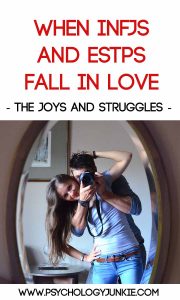
Get Your Free INFJ eBook
As a thank you for subscribing to my newsletter I will send you this free eBook PACKED with self-care tips, creativity hacks, and more! You'll also get a 3-day email course for understanding your personality type better!


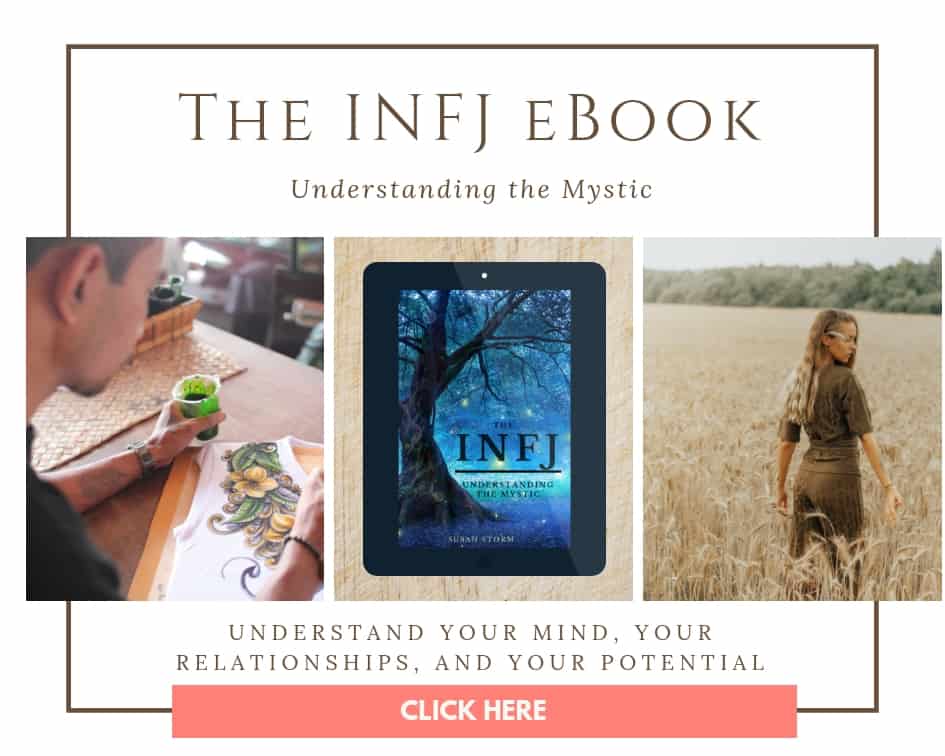
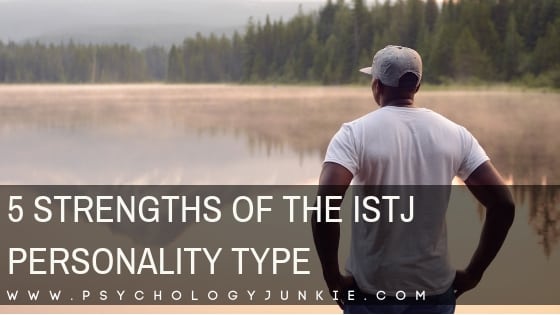
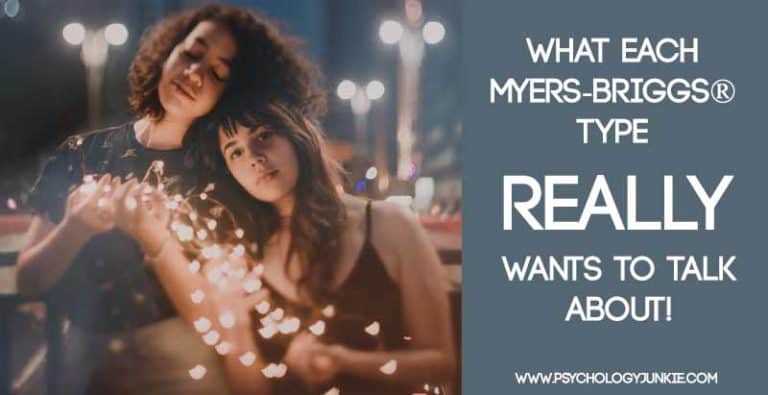
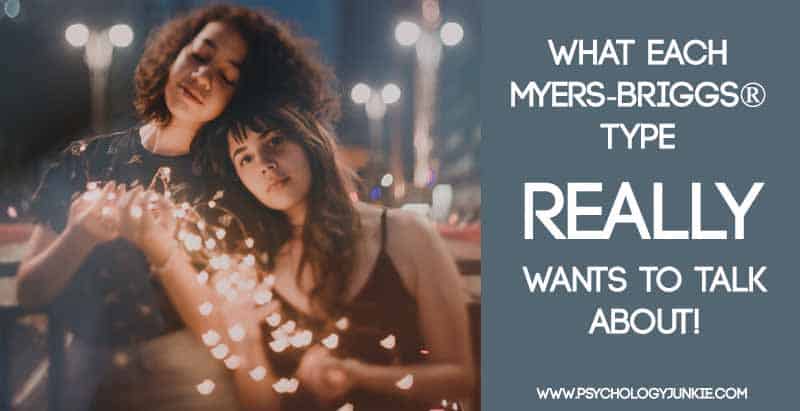
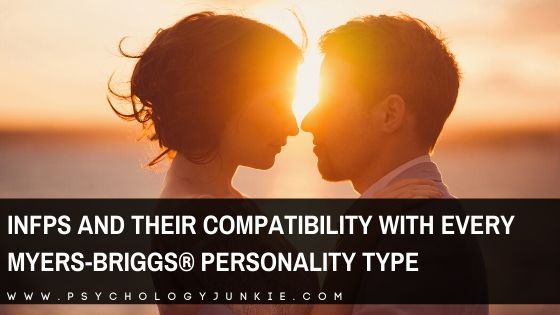
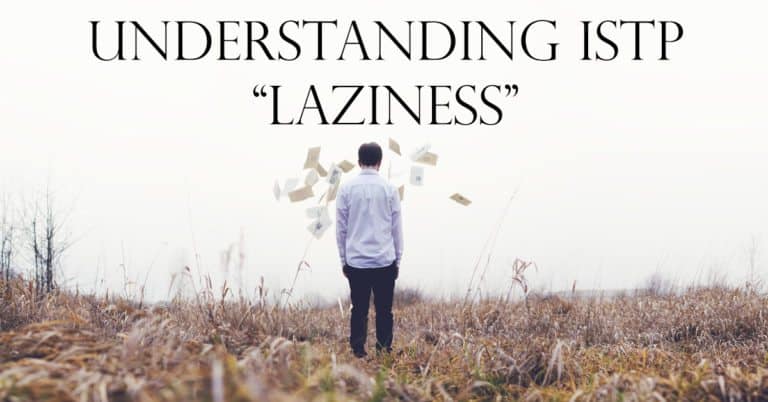
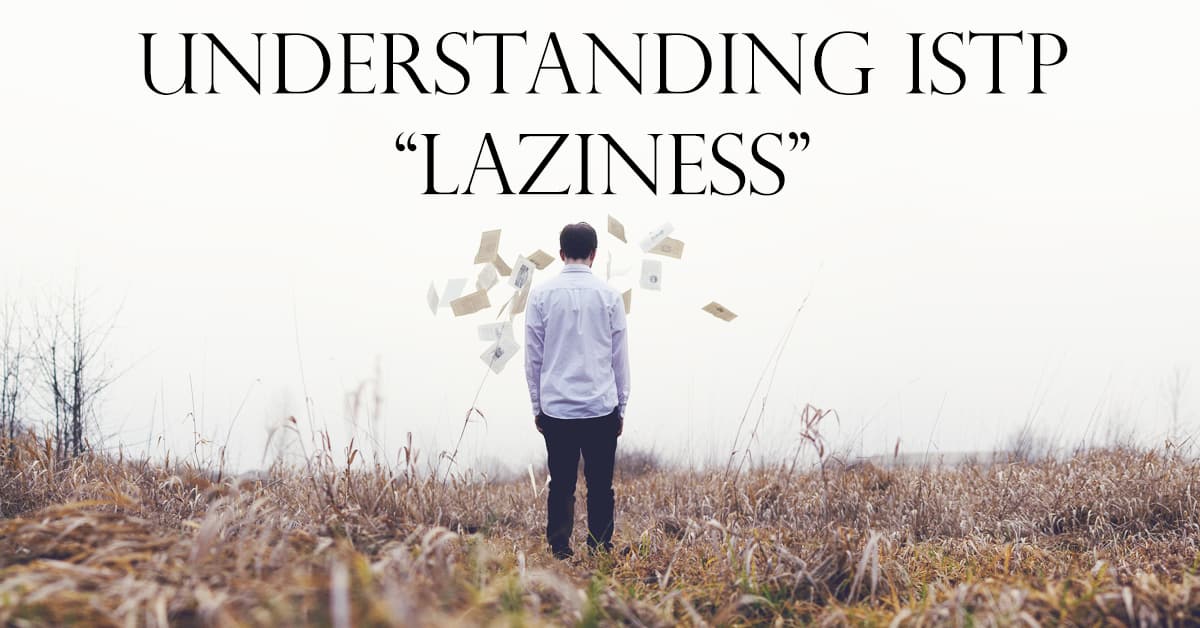
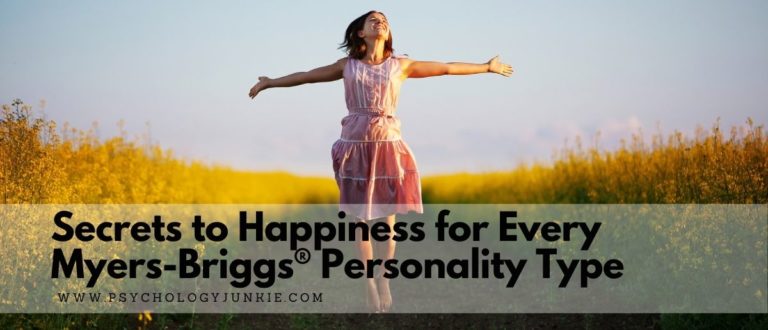

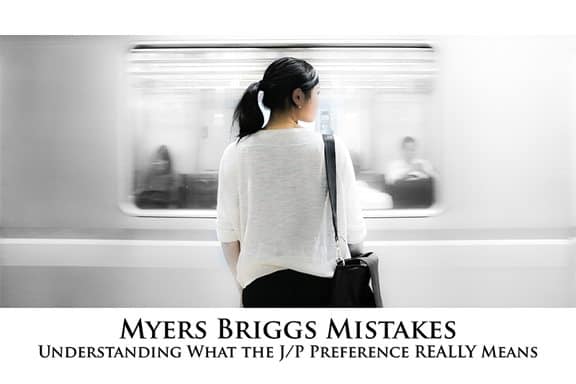
“Keep in mind: Most people who type as INFJ from online tests are actually INFPs or ISFPs, so these particular pros and cons may be very different if you’re dealing with mistypes.” Okay, may I ask what’s the evidence behind this statement?
Good question. I’ll probably go in and re-write this to make sure it’s clear that this is my own experience as an MBTI practitioner, as well as the experience of every other type profiler or MBTI practitioner that I know. Most people at the moment are getting their type results from a web site called 16 Personalities. The questionnaire is highly inaccurate and tends to skew intuitive for everyone. When I’ve worked with individuals who want help finding their type, most started at a site like 16 personalities, then realized things weren’t fitting for them, then they took the official MBTI questionnaire or worked with a profiler and found out they had a different type. In many cases, people who got an INFJ result in an online questionnaire wound up being ISFPs or INFJs.